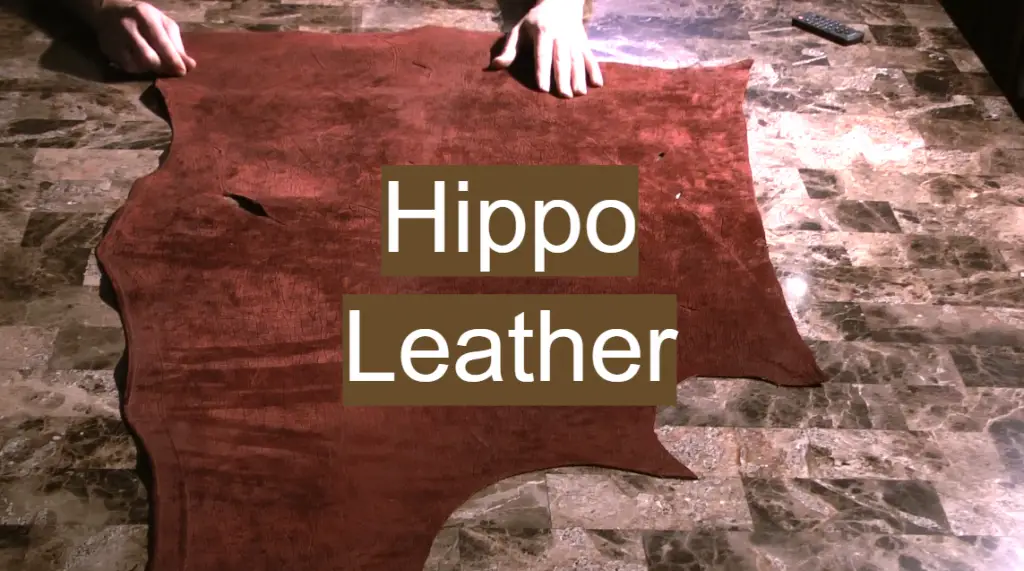
Hippo leather is the very dense hide of a hippopotamus. The leather of a hippo is quite unusual. There are two major types of hippo leather – standard grey color and pigmented.
Just like elephant Leather, the hippopotamus leather is probably one of the most exclusive and uncommon leathers, when it comes to the limited quantity of leather panels that go into processing. Genuine hippo leather originates from animals that were not slaughtered but died from natural causes. That is why the average price for a medium hippo leather panel is higher during the non-harvest time. And it is really one of the rarest leather materials in the world.
Also, keep in mind that hippo leather is very coarse in its initial condition and deeply scarred. Manual sanding eliminates the outermost grain before any of the scars are gone.
Interesting fact: the top grain layer is left rough to make durable boots. For other products, only the bottom layer of hippo leather is used.
Properties
Natural hippopotamus leather is only 6 inches deep and 2 inches thick. Before the processing, hippo leather looks a bit rough and dirty because of the habitat. Also, the color is mostly dark.
The texture of its natural grain surface is always noticeable. It appears like the lines drawn out of wet mud with a knife. The multiple injury marks on the surface of these animals are often visible. The leather piece has the same scars the animal had when it was alive.
By the first look, hippo leather is somewhat similar to elephant leather but is tanned mostly with a nubuck/suede coating to a very soft finish. Also, hippo leather is very sturdy and solid, and if it is properly cared for, it gets weaker with age.
The natural wrinkled hippo leather is irregular in its appearance but comes with a grain and nubuck finish. It looks and even sounds like suede. Usually, the material is tanned to be smooth to the touch.
The hippo leather material is between 1.5 and 2.2 mm, this exotic leather is particularly robust due to its thickness. A skillful craftsman is able to make genuinely exquisite leather items such as belts, purses, and tiny leather objects between the scars, the differences of coloring and wrinkle patterns that are as distinctive as fingerprints. In order to produce a consistent coloration and seamless, unnoticeable stitching, it takes a considerable amount of professional skills and a meticulous selection of hide materials.
However, hippos spend a tremendous amount of time in the sea, so it makes sense that they have formed a kind of natural guard that helps to repel water. As for the natural colors, hippo leather shades are often usually neutral, but generally are more even and less speckled than would be elephant leather.
Each piece of hippo leather is special as a natural material, so please be mindful that no two animals are precisely the same and the measurements are estimated.
How to recognize hippo leather?
After processing, natural hippo leather is remarkably smooth and voluptuous. You won’t confuse it with any other natural leather because of the unique pattern and texture.
It is also super soft, obviously, though remaining relaxed and solid at the same time. You may select whether you like a more suede velvet finish or a softer calf-like look. The finish depends on the manufacturer’s preferences.
This leather material is characterized by specific lines. Just like fingertips, these lines are unique for each piece. Also, even after being processed, natural hippo leather has some cuts, scratches and other scars that emphasize the leather’s beauty and remind about its animal origin.
Uses
Hippo leather is mostly used for accessories. You may find hippo leather bags, watch straps, tablet/smartphone covers, suitcases, work gloves, belts and holsters. It resembles reptile skin and that is why all the products in this range may have hippo leather alternatives. Also, it is a quite new player in the shoe-making industry.
Benefits:
- Exotic grain pattern;
- Soft;
- Durable;
- Comfortable to work with;
- Water-resistant (not fully waterproof);
The hippopotamus leather is superbly smooth and velvety to the touch and has an utterly stunning striated look. As well as being genuinely solid and comfortable, it is highly resilient and robust. Hippo leather still bears wounds of the animal from the enormous wars fought over its lifespan and these are the finished leather’s wonderful qualities.
Care and maintenance
Occasionally, you should clean any leather products and hippo leather is not an exception at this point. To clear loose dirt and dust from its suede finish, a brass bristle brush is the best tool. Polish the leather piece and it will become smooth. The suede finish may be maintained by using commercial preparation of high quality, and very good cleaning solutions are also available.
A light brushing and an injection of Scotchguard and/or silicone do a good job to maintain the cleaned hippo looking new and safe. Another choice is Kelly’s Suede Leather Water & Stain Protector.
Hippo leather can be preserved in 2 ways:
1) The first step is cleaning
Make sure you have a good leather cleaner to use on your hippo leather purse or shoes before you start. Opt for buying a specific leather cleaner for exotic materials, since depending on the substance they are used on, certain leather cleaners and leather conditioners may have unexpected results. Keep away from leather cleaners that contain alcohol, since alcohol appears to more seriously dry out exotic leather than cowhide pieces.
A safe way to make sure that your cleaner is correct for you is to pre-test it before adding it to the whole piece. Try a small amount on a discrete spot. Using a white cloth to dab the leather with the cleaner while you pre-test, then wait an hour. If, after an hour has passed, there is a difference in the hue of hippo leather or you darkening, do not use the tested cleaning agent. That is why it’s better to stick to all-natural, alcohol-free products for cleaning and conditioning hippo leather.
Here is how your hippo leather care routine should be:
- Apply a tiny volume of a natural leather cleaner;
- Clean it in a circular motion with a wet rag;
- Continue until the whole surface is clean and shiny;
- Finish cleaning with a clean and dry cloth;
2) The next stage is conditioning
It is time to condition the leather after you are finished using the leather cleaner. To complete the conditioning process, you can use similar measures, only that you will have to use a gentle conditioner designed for exotic leather to prevent getting it so sticky, ensuring that it does not harm this delicate material. Here is what you should do:
- Add a tiny amount of leather conditioner to a clean and dry cloth;
- Rub in circular gestures on the leather surface;
- Leave it to dry and then use a dry, clean cloth to gently buff the surface;
To help the hippo leather to preserve its unique form and appearance, it is better to store such products in an environment that is dry and cool. And if your hippo leather piece has not been used for a while, it should be washed and conditioned properly to maintain its long-term vitality every few months.
Final thoughts
The way the hippo leather does, no other leather shocks people. Looking at hippo leather, you might not imagine that the skin would be as fluffy as it is. Surely, it doesn’t remind gorilla’s skin, except with one main difference: on top of the skin lies a thick, subtle peach fuzz like texture.









